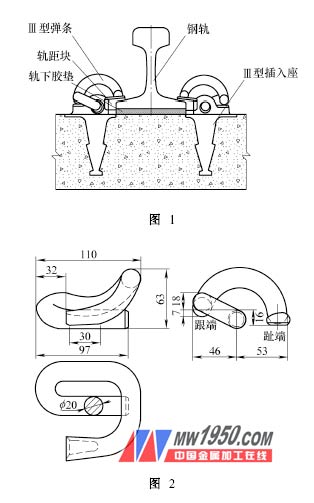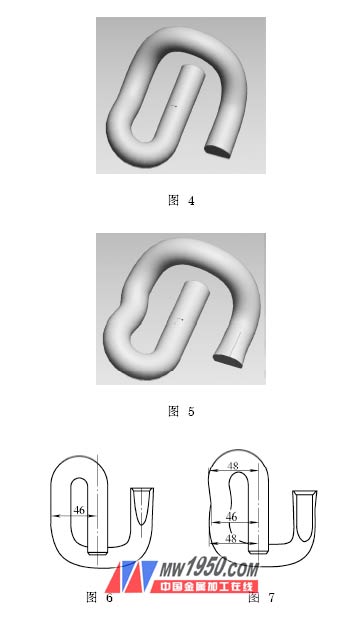The elastic strip type III fastener is used to connect the standard gauge heavy-duty, fast, high-speed railway and the 60kg/m rail and the non-shoulder type III prestressed concrete sleeper with a curve radius of not less than 350m. With the development of China's national economy and the continuous improvement of railway transportation speed, the requirements for railway fastener elasticity, vibration reduction effect and buckle pressure stability have also been continuously improved. Therefore, the buckle pressure stability of the spring type III fastener when assembled in a standard state is a key quality characteristic. After the elastic deformation test of the elastic strip, the permanent deformation value of the toe end shall not be greater than 1.0 mm, which is a key technical index (see Figure 1 for the installation form of the elastic strip type III fastener, and Figure 2 for the geometrical dimensions of the elastic strip). In 2001, our company carried out a trial production of the elastic type III fasteners. In the same year, it passed the acceptance of the Ministry of Railways expert group and started mass production. 1. Proposal of the problem 2. Establish a three-dimensional solid model of the different heel shape of the elastic strip III fastener The parametric technology first proposed by Pro/engineering software is called the third technological revolution in the history of CAD technology. With powerful parametric design and unified database management, he realized the feature size drive and bidirectional association drive of 3D solid and 2D engineering drawings, solid feature modeling, component assembly, NC machining and other functions, overcoming 2D. Graphics cannot contain all the design information of the product. In order to facilitate future analysis, we have established two models (see Figure 4, Figure 5). We refer to qualified products (see Figure 4) as CLIP-3; unqualified products (see Figure 5) are CLIP-3-1. The difference between the two is that the shape of the heel is different (see Figure 6 and Figure 7). Next page 
The processing technology of the elastic strip type III fastener is: blanking→heating→bending forming→heat treatment. According to the above production process, we have produced the production of the spring type III fastener. In the case of the residual deformation test of the finished product, sometimes the toe permanent deformation value is greater than 1.0 mm. As this is a key technical indicator, its unqualified will directly affect the safe operation of the train and bring hidden dangers to the railway transportation, which has caused us to attach great importance to it. Therefore, we conducted in-depth analysis and research on unqualified products. In the residual deformation test of the elastic strip type III fastener, the toe end permanent deformation value is determined by the heat treatment quality and geometric size of the product. We tested the hardness of the unqualified products and reached the hardness required by the design (44 ~ 48 HRC). It can be seen that there is no problem in the heat treatment process. Therefore, the initial judgment is caused by a problem with its geometric size. Moreover, we found that products with unacceptable residual deformation tests generally have lateral bending of the heel (see Figure 3). To this end, we analyzed the effect of the shape of the toe end of the elastic strip III fastener on the permanent deformation value of the residual deformation test. 
To accurately analyze the influence of the shape of the end of the elastic strip type III fastener on the permanent deformation value of the toe end of the residual deformation test, it is necessary to analyze the structure in engineering mechanics. Before the structural analysis, a three-dimensional solid model of the product must be established. Due to the poor modeling capabilities of some professional structural analysis software, we use the Pro/ engi neer software platform to build 3D solid models. Pro/ engineer software is a product introduced by Para ( metric Technology Corporati on ) in 1989. It is a CAD / CAE / CAM software system for 3D design, processing, analysis and drawing of products. The software is known for its ease of use, parametric feature modeling and the full relevance of the system. At present, Pro/engineer software has been widely used in China's electronics, home appliances, molds and welding industries, and is one of the largest number of foreign CAD/CAM software users in China. 
Effect of the shape of the fastener's heel end on the permanent deformation value of the toe end after the residual deformation test
